 What would you tell someone if they asked how Email Marketing helps your business?
What would you tell someone if they asked how Email Marketing helps your business?
You probably wear many hats in your small business, or non-profit. And numbers may not be your strongest suit.
You would rather connect with people face-to-face to sell your products or services, or raise awareness of your nonprofit.
What are the benefits of email marketing?
We’ll take the mystery and dread out of measuring your email marketing so that you can feel confident in your ability to achieve your business goals.
Learn more about how to measure your email marketing success. Join Constant contact for a FREE Webinar, View the Impact of Email Marketing With Reports. Can’t attend live? Register anyway. Constant Contact sends you a recording.
Measure email performance using the Triple A Approach
1. Analyze
You need to know how to interpret the results from your email campaigns.
Email marketing tools such as Constant contact offer easy-to read reports that allow you to track the success of your marketing in real time.
This is what Constant Contact’s reporting dashboard looks.
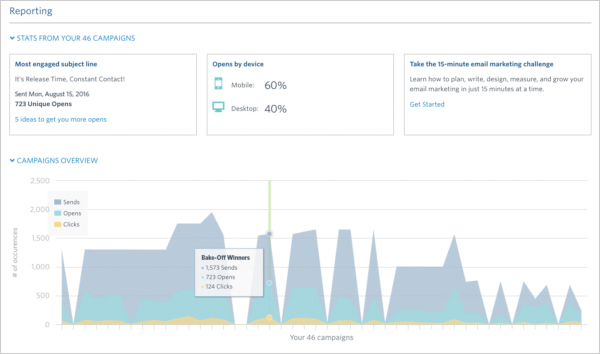
Begin by examining the rates of click-through and open for your most recent email campaigns. Compare your results to the averages of your industry.
Constant Contact’s Industry Average Chart allows you to easily compare your campaign to other campaigns in your industry.
You might be encouraged to learn that you are in great shape if your open rate is at least 17 percent and you have a click-through rate of nine percent. This is a good level of engagement for any industry.
You now have a benchmark for your email marketing. It’s time to look beyond the number of opens and clicks to see what impact your emails have on your bottom line.
2. You can also assess
Why bother with marketing campaigns if they don’t support your business objectives?
Our worksheets will help you track email marketing metrics as well as goals for your business. This way, you’ll always know how your marketing is supporting your business.
Two different worksheets are available depending on your business goals:
If you are sending a sales e-mail, print and download this worksheet so that you can keep track of the results.

* Are you sending a newsletter to the general public? This is the worksheet for you.
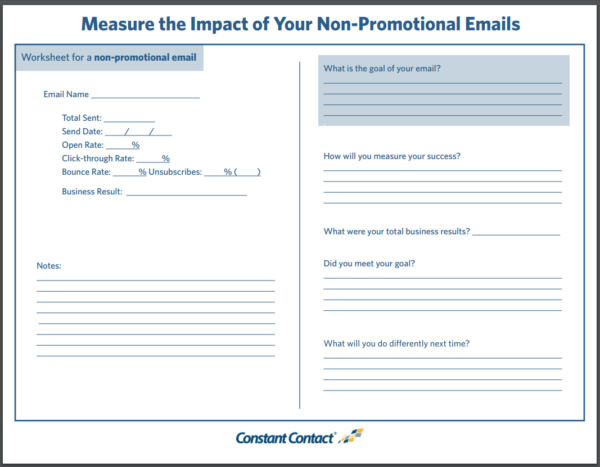
Fill out the worksheets before you send your email campaign. Answer two important questions. What is the purpose of the email? What will you use to measure your success?
Think about the goal you want to achieve with your campaign. Do you want to increase the number of people who register for a fundraiser event? You want to sell 20% more than you did last year. You want to book three new consultations.
The more specific your goal, the better. You’ll be able to tell in a single glance whether you have achieved your goal.
Visit your email reports two days after you sent the email and complete your worksheets.
Focus on these key metrics:
Total Sent: The total number of recipients to whom you have sent an email
* Date of Send: The date that an email was sent out to subscribers
* Open Rate: The percentage of subscribers that opened your email
*Click-through rate: The percentage of subscribers that opened and clicked links in your email
Bounce rate: percentage of emails not delivered to intended recipients
Unsubscribe/Opt out rate: An unsubscribe, or “opt-out”, occurs when one of your contacts does not want to receive your email and unsubscribes.
Tip Require that subscribers give a reason why they want to opt out of your emails.
3. Adjustment
Marketing magic is created in the final stage.
Answer the following questions using the statistics you entered on your worksheets:
What was your total business result?
This should be fairly straightforward for a non-promotional e-mail. Compile the results of a promotional email based on time to determine your total business outcome.
Did you meet your goal?
This should be a yes or no question, depending on what you wanted to achieve at the start.
Let’s get to the fun part.
You can optimize your marketing strategy once you’ve analyzed how well an email worked and whether it helped you achieve your goals.
Say you are reviewing your email reports and you discover that you have a very high open rate but a very low click-through rates. This means people opened your email but didn’t click on the links in it.
Here’s how to improve your click-through rates in your next email:
* Check the calls to actions in your email. Look at the language of your call-to-action – is it clear and compelling? Does it tell people what action to take and why?
Create more whitespace to make the email feel less overwhelming. Break up topics if your email has multiple sections so that readers can select what they wish to read. It may be a good idea to break up the topics into separate emails so that you can send shorter emails more often.
* Consider how much content you have in your email. Limit it to one picture, one paragraph and a call-to action that is easy to locate and click. You may confuse readers if you use too many (or no) calls-to action.
Let’s take a look at another scenario:
What should you do when you have a high open rate but a low click through rate?
It tells you, that even though not many people have opened your email, those who did did showed a great interest in the content.
You can encourage more people to read your emails and see the great content you have included:
Find the best time to send. – Do you send at times and days when the majority of subscribers will read your emails? Find out the best time to send your email.
Try a new subject line. Copy your email and resend it with a more appropriate subject line. will only resend your email to those contacts who did not open it. Then, you’ll have two separate reports to Use a poll to find out what your audience wants to read.
This chart can help you adjust your marketing strategy to reach your business objectives and improve your marketing.
Increase your confidence in email marketing results
It’s not everyone’s favourite thing to do, but measuring your email marketing will help you save time, money and effort.
It’s definitely something to be excited about.


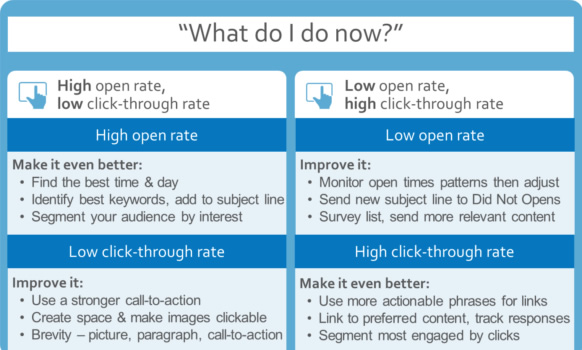





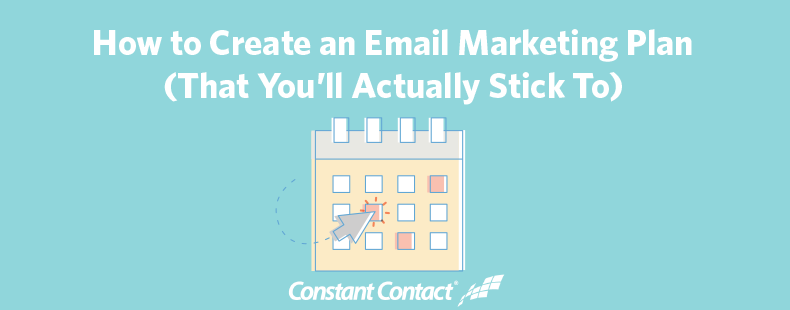
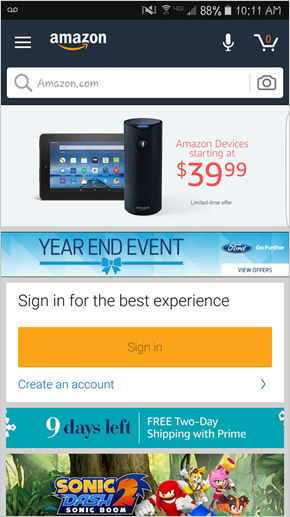

Leave a Reply